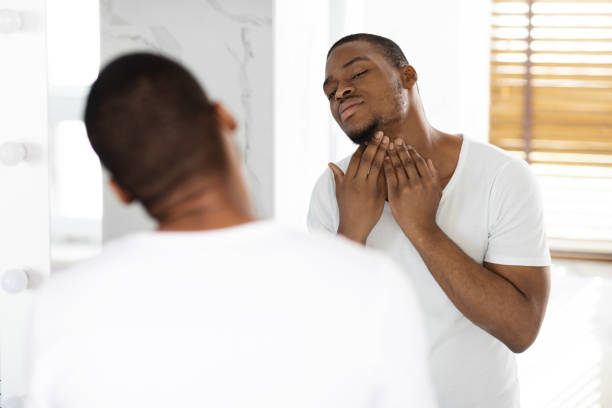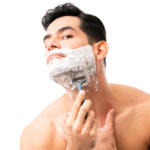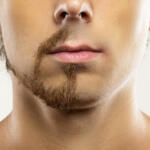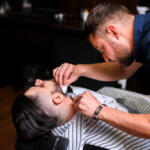
Have you ever been caught off guard by an unexpected discomfort and wondered, “What’s causing this annoyance?” For many, this unexpected guest is an ingrown hair.
Table Of Contents
−Anyone who has felt the sting and irritation brought on by these sneaky, inward-turning strands recognizes the need for a clear understanding of this widespread skin challenge. Ready to dive deep into this topic? Let’s jump in!
The Pain of Ingrown Hairs: Is It Real?
Absolutely, ingrown hairs can be a genuine source of discomfort. Activities like shaving, tweezing, or waxing might occasionally cause the hair to grow back towards the skin. This backward growth can lead to a small area of infection, often revealing itself through symptoms such as red patches, swelling, sensitivity, and even the formation of whiteheads.
Thankfully, most ingrown hairs find their way out within a span of one to two weeks. Yet, a few measures like utilizing a sharp blade, exfoliating your skin periodically, and applying moisturizer after hair removal can speed up recovery while sidestepping future incidents.
But Why Do Ingrown Hairs Inflict Pain?
These misdirected hairs bring pain by poking back into the skin, leading to a minor infection. Symptoms like redness, swelling, and soreness, coupled with whiteheads or pus, mark this infection.
Regular hair removal zones, such as the face, neck, and pubic region, often witness ingrown hairs. To lessen this unease, consider cutting back on frequent shaving, tweezing, or waxing. Also, pre and post hair-removal exfoliation can deter ingrown hairs by clearing away dead skin, which may otherwise block hair growth.
Combatting Ingrown Hair Discomfort
If you’re contending with these pesky strands, consider these measures:
- Over-the-Counter Antibiotic Creams: Opt for something like Neosporin to address the infection.
- Cool, Wet Cloth: A brief application can provide relief.
- After-Shave Soothers: These might ease post-shaving irritation.
- Gentle Exfoliation: This method can free trapped hairs.
- Warm Compresses: Regular application can make the ingrown hair surface and drain.
- Aspirin-Honey Blend: This mix might alleviate ingrown hair pain.
Distinguishing Ingrown Hair from a Pimple
Though ingrown hairs and pimples can look alike – think red, inflamed skin protrusions – their origins vary. While ingrown hairs are the result of inward hair growth, pimples stem from oil and bacteria accumulation within skin pores. An evident hair strand typically signifies an ingrown hair, in contrast to a pimple. It’s vital to spot the difference, as overlooked ingrown hairs can grow into deeper cysts.
Identifying an Infection
An infected ingrown hair might resemble a raised, reddened, itchy patch, potentially with the hair visible beneath the skin. Swelling, redness, itchiness, and pimple-like formations filled with pus signal an infection. Upon observing these signs, a doctor’s visit becomes essential.
Who’s At Risk?
Certain behaviors and attributes elevate ingrown hair risks. Tightly curled hair, frequent shaving, tweezing or waxing, and unsuitable methods can contribute. Individuals with dense or rough hair also report a higher incidence.
Diagnosis and Caution
Mostly, a simple skin check can identify an ingrown hair. However, if a deeper cyst is suspected, your doctor might suggest further tests. Seeking a dermatologist’s expertise can ensure the right diagnosis and treatment advice.
Resist the urge to squeeze an ingrown hair cyst. This act might allow more bacteria to invade, causing an infection and possibly leaving behind scars. Opt for gentle cleaning, apply antibacterial creams, and, if required, seek medical attention.
Seeking Medical Intervention: When and Why?
In situations where the skin around an ingrown hair turns red, swollen, itchy, or pus-filled, it’s time to consult a doctor. Persistent pain or an infection might prompt your doctor to suggest antibiotics, a specific cream, or even a minor surgical procedure to extract the errant hair.
Final Thoughts: Nurture Your Skin
At its core, while ingrown hairs might challenge us with their irritation, grasping the issue and its solutions can offer solace. Commit to suitable skincare to bolster your skin’s health and fend off troublesome ingrown hairs. Cherish your skin – it’s the only one you’ve got – and relish a life unburdened by the pains of ingrown hairs.
Last update on 2024-04-24 / Affiliate links / Images from Amazon Product Advertising API
Affiliate Disclosure: This post contains affiliate links, which means I may receive a small commission, at no extra cost to you, if you make a purchase using these links.

Jay Kang
Just because i'm asian does not mean I don't need shaving. I always wanted to grow a beard when I was young, now I need to shave because hair growth for me is a problem. I'm going through what every man will and has gone through before.





